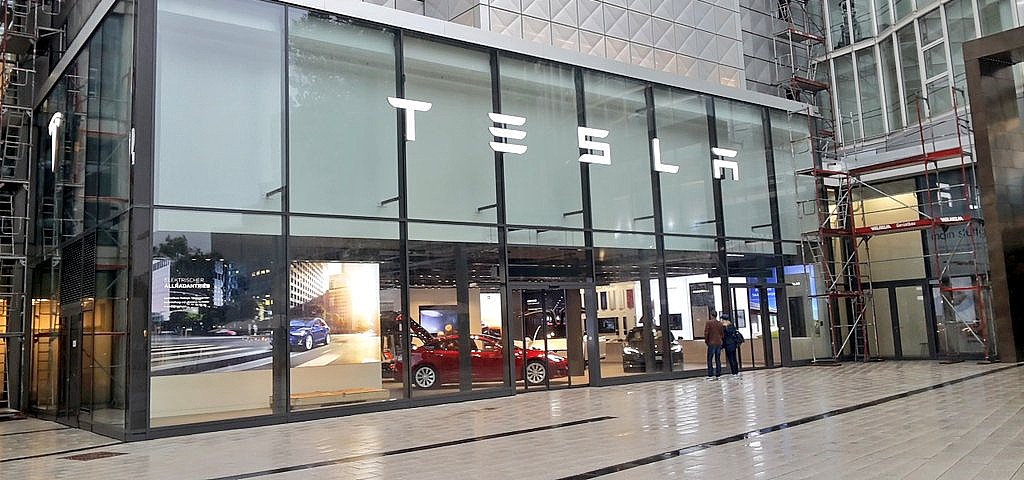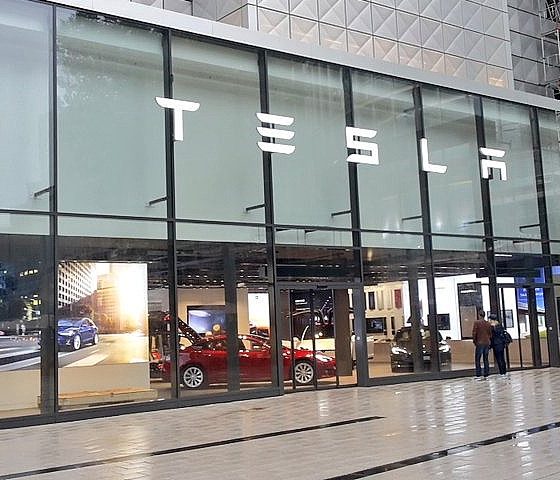

News
Tesla’s direct-to-consumer model is better for companies and consumers
A study published on price gouging shows Tesla’s direct-to-consumer model protects its brand and offers a better customer experience.
The study, published by the research group Growth from Knowledge, shows that price gouging is not only damaging to dealerships but also to the brands that they represent. Hence, Tesla’s lack of dealers ensures that customers are protected from the poor experience of paying over MSRP.
Most startling from the report is that 80% of car buyers between May and June of this year paid at or above MSRP when they bought their new vehicle. Of those who spent above MSRP, 31% would not buy from the same dealer again, while 27% would no longer buy from the same manufacturer. Alternatively, customers who paid at MSRP had a far better experience; only 14% chose not to buy from the dealer again, and 10% decided not to buy from the manufacturer again.
Researchers found four statistically significant poor experiences that many customers faced. Of those who paid above MSRP, 34% paid fees that they had never heard of, 31% purchased a model that wasn’t their first choice, 30% compromised on features they wanted, and 30% bought from dealers who weren’t their first choice.
The consistent and high amount of poor customer service even bled into popular culture. Many sites now offer links to “markup trackers” that hope to document and highlight price gouging. On social media, many now use the nickname “stealership” to label dealers who have unjustly raised prices above MSRP.
Ford dealer emailed me today with a brand new @Ford Lightning they have for immediate sale. Just a cool $37,000 OVER MSRP. #pass I’m sure all the reservation holders in the area would love to see their exact build for sale instead of being delivered to them. Why I hate dealers. pic.twitter.com/zym8cLGe0d
— Erik in DÆrik (@teslainventory) August 12, 2022
From a manufacturer’s perspective, despite its advantages, the dealership model has a significant problem. Manufacturers have such little control over the buying experience of their customers that they can’t even control the price which their products are sold for. All the while, their brand is plastered over the entire experience, meaning that despite the brand not owning the dealership, customers (as this study has shown) link their experience with the brand of vehicle they buy.
It is important to recognize that dealers offer a critical service in being available for customer maintenance, recall work, and other support roles. For instance, when a car buyer buys a Ford vehicle, they now have easy access to a vast dealer network that will, no matter where they live, be able to fix their vehicle, do important safety recall work, and even be open to them if their vehicle breaks down away from home. Transversely, manufacturers that have begun to offer direct-to-consumer models must now build out their service network to complete all of the same services.
This situation could push manufacturers to blend the dealership model with direct-to-consumer, allowing their vast service networks to remain while overcoming issues with dealerships’ poor customer service. This change may also offer a unique opportunity for manufacturers to provide new buying models for the vehicles, such as subscriptions, that were previously impossible.
What do you think of the article? Do you have any comments, questions, or concerns? Shoot me an email at william@teslarati.com. You can also reach me on Twitter @WilliamWritin. If you have news tips, email us at tips@teslarati.com!

News
Tesla FSD fleet is nearing 7 billion total miles, including 2.5 billion city miles
As can be seen on Tesla’s official FSD webpage, vehicles equipped with the system have now navigated over 6.99 billion miles.

Tesla’s Full Self-Driving (Supervised) fleet is closing in on almost 7 billion total miles driven, as per data posted by the company on its official FSD webpage.
These figures hint at the massive scale of data fueling Tesla’s rapid FSD improvements, which have been quite notable as of late.
FSD mileage milestones
As can be seen on Tesla’s official FSD webpage, vehicles equipped with the system have now navigated over 6.99 billion miles. Tesla owner and avid FSD tester Whole Mars Catalog also shared a screenshot indicating that from the nearly 7 billion miles traveled by the FSD fleet, more than 2.5 billion miles were driven inside cities.
City miles are particularly valuable for complex urban scenarios like unprotected turns, pedestrian interactions, and traffic lights. This is also the difference-maker for FSD, as only complex solutions, such as Waymo’s self-driving taxis, operate similarly on inner-city streets. And even then, incidents such as the San Francisco blackouts have proven challenging for sensor-rich vehicles like Waymos.
Tesla’s data edge
Tesla has a number of advantages in the autonomous vehicle sector, one of which is the size of its fleet and the number of vehicles training FSD on real-world roads. Tesla’s nearly 7 billion FSD miles then allow the company to roll out updates that make its vehicles behave like they are being driven by experienced drivers, even if they are operating on their own.
So notable are Tesla’s improvements to FSD that NVIDIA Director of Robotics Jim Fan, after experiencing FSD v14, noted that the system is the first AI that passes what he described as a “Physical Turing Test.”
“Despite knowing exactly how robot learning works, I still find it magical watching the steering wheel turn by itself. First it feels surreal, next it becomes routine. Then, like the smartphone, taking it away actively hurts. This is how humanity gets rewired and glued to god-like technologies,” Fan wrote in a post on X.
News
Tesla starts showing how FSD will change lives in Europe
Local officials tested the system on narrow country roads and were impressed by FSD’s smooth, human-like driving, with some calling the service a game-changer for everyday life in areas that are far from urban centers.

Tesla has launched Europe’s first public shuttle service using Full Self-Driving (Supervised) in the rural Eifelkreis Bitburg-Prüm region of Germany, demonstrating how the technology can restore independence and mobility for people who struggle with limited transport options.
Local officials tested the system on narrow country roads and were impressed by FSD’s smooth, human-like driving, with some calling the service a game-changer for everyday life in areas that are far from urban centers.
Officials see real impact on rural residents
Arzfeld Mayor Johannes Kuhl and District Administrator Andreas Kruppert personally tested the Tesla shuttle service. This allowed them to see just how well FSD navigated winding lanes and rural roads confidently. Kruppert said, “Autonomous driving sounds like science fiction to many, but we simply see here that it works totally well in rural regions too.” Kuhl, for his part, also noted that FSD “feels like a very experienced driver.”
The pilot complements the area’s “Citizen Bus” program, which provides on-demand rides for elderly residents who can no longer drive themselves. Tesla Europe shared a video of a demonstration of the service, highlighting how FSD gives people their freedom back, even in places where public transport is not as prevalent.
What the Ministry for Economic Affairs and Transport says
Rhineland-Palatinate’s Minister Daniela Schmitt supported the project, praising the collaboration that made this “first of its kind in Europe” possible. As per the ministry, the rural rollout for the service shows FSD’s potential beyond major cities, and it delivers tangible benefits like grocery runs, doctor visits, and social connections for isolated residents.
“Reliable and flexible mobility is especially vital in rural areas. With the launch of a shuttle service using self-driving vehicles (FSD supervised) by Tesla in the Eifelkreis Bitburg-Prüm, an innovative pilot project is now getting underway that complements local community bus services. It is the first project of its kind in Europe.
“The result is a real gain for rural mobility: greater accessibility, more flexibility and tangible benefits for everyday life. A strong signal for innovation, cooperation and future-oriented mobility beyond urban centers,” the ministry wrote in a LinkedIn post.
News
Tesla China quietly posts Robotaxi-related job listing
Tesla China is currently seeking a Low Voltage Electrical Engineer to work on circuit board design for the company’s autonomous vehicles.

Tesla has posted a new job listing in Shanghai explicitly tied to its Robotaxi program, fueling speculation that the company is preparing to launch its dedicated autonomous ride-hailing service in China.
As noted in the listing, Tesla China is currently seeking a Low Voltage Electrical Engineer to work on circuit board design for the company’s autonomous vehicles.
Robotaxi-specific role
The listing, which was shared on social media platform X by industry watcher @tslaming, suggested that Tesla China is looking to fill the role urgently. The job listing itself specifically mentions that the person hired for the role will be working on the Low Voltage Hardware team, which would design the circuit boards that would serve as the nervous system of the Robotaxi.
Key tasks for the role, as indicated in the job listing, include collaboration with PCB layout, firmware, mechanical, program management, and validation teams, among other responsibilities. The role is based in Shanghai.
China Robotaxi launch
China represents a massive potential market for robotaxis, with its dense urban centers and supportive policies in select cities. Tesla has limited permission to roll out FSD in the country, though despite this, its vehicles have been hailed as among the best in the market when it comes to autonomous features. So far, at least, it appears that China supports Tesla’s FSD and Robotaxi rollout.
This was hinted at in November, when Tesla brought the Cybercab to the 8th China International Import Expo (CIIE) in Shanghai, marking the first time that the autonomous two-seater was brought to the Asia-Pacific region. The vehicle, despite not having a release date in China, received a significant amount of interest among the event’s attendees.








